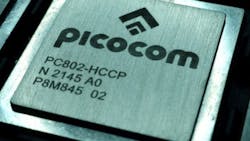Picocom’s 5G NR Small-Cell SoC Gives OpenRAN A Boost
The Overview
With the introduction of its PC802 system-on-chip (SoC), Picocom claims to offer the world’s first 4G/5G device dedicated to developing small cells with integrated support for Open RAN standards. The device supports disaggregated and integrated 5G small-cell platforms, including residential, enterprise and industrial networks, neutral-host networks, and outdoor networks.
Who Needs It and Why?
The Open RAN movement seeks to bring more openness and interoperability to the hardware and software comprising radio-access networks (RANs). Spearheaded by the O-RAN Alliance, an Open RAN ecosystem is coalescing around the concept of an open, intelligent, virtualized, and fully interoperable RAN that will theoretically improve the efficiency of RAN deployments and operation by mobile network providers.
To that end, Picocom’s purpose-built physical-layer (PHY) SoC facilitates the design and production of Open RAN-compliant small cells ready for integration into the broader network fabric. It’s hoped that by delivering optimized silicon designed expressly for Open RAN, the flexible, low-power SoC will drive innovation in 5G New Radio (NR) open small-cell products.
Under the Hood
The PC802 PHY SoC includes support for industry-leading Open RAN specifications, and interfaces with a layer 2/3 stack via the SCF FAPI interface over PCIe. The PC802 supports seamless interfacing to radio units (O-RU) via the O-RAN Open Fronthaul (eCPRI) interface or directly to RFICs with a standardized JESD204B high-speed serial interface.
The PC802 SoC is optimized for disaggregated small cells. It employs the FAPI protocol (defined by the Small Cell Forum) to communicate with and provide physical-layer services to the MAC. It has an integrated O-RAN Alliance Open Fronthaul interface (based on eCPRI) to connect and communicate with Open RAN (remote) radio units (RUs), as well as JESD204B interfaces to connect gluelessly with commonly available radio transceivers.
For small-cell applications, the PC802 device transforms FAPI messages from the L2/3 into IQ samples for the radio and vice versa. This includes driving the external physical and software interfaces, PHY processing and Digital Front End (DFE) functions.
The PC802 is also optimized to provide upper PHY processing in an O-RAN Alliance O-DU. It achieves this by transforming the FAPI messages from the L2/3 into frequency domain IQ samples using eCPRI and Open fronthaul messages, which can be transmitted over the Ethernet to O-RU remote radio units.
Picocom expects to deliver PC802 SoCs to lead customers by the end of 2021 and to see end products incorporating the device in field trials during 2022.
About the Author
David Maliniak
Executive Editor, Microwaves & RF
I am Executive Editor of Microwaves & RF, an all-digital publication that broadly covers all aspects of wireless communications. More particularly, we're keeping a close eye on technologies in the consumer-oriented 5G, 6G, IoT, M2M, and V2X markets, in which much of the wireless market's growth will occur in this decade and beyond. I work with a great team of editors to provide engineers, developers, and technical managers with interesting and useful articles and videos on a regular basis. Check out our free newsletters to see the latest content.
You can send press releases for new products for possible coverage on the website. I am also interested in receiving contributed articles for publishing on our website. Use our contributor's packet, in which you'll find an article template and lots more useful information on how to properly prepare content for us, and send to me along with a signed release form.
About me:
In his long career in the B2B electronics-industry media, David Maliniak has held editorial roles as both generalist and specialist. As Components Editor and, later, as Editor in Chief of EE Product News, David gained breadth of experience in covering the industry at large. In serving as EDA/Test and Measurement Technology Editor at Electronic Design, he developed deep insight into those complex areas of technology. Most recently, David worked in technical marketing communications at Teledyne LeCroy, leaving to rejoin the EOEM B2B publishing world in January 2020. David earned a B.A. in journalism at New York University.

